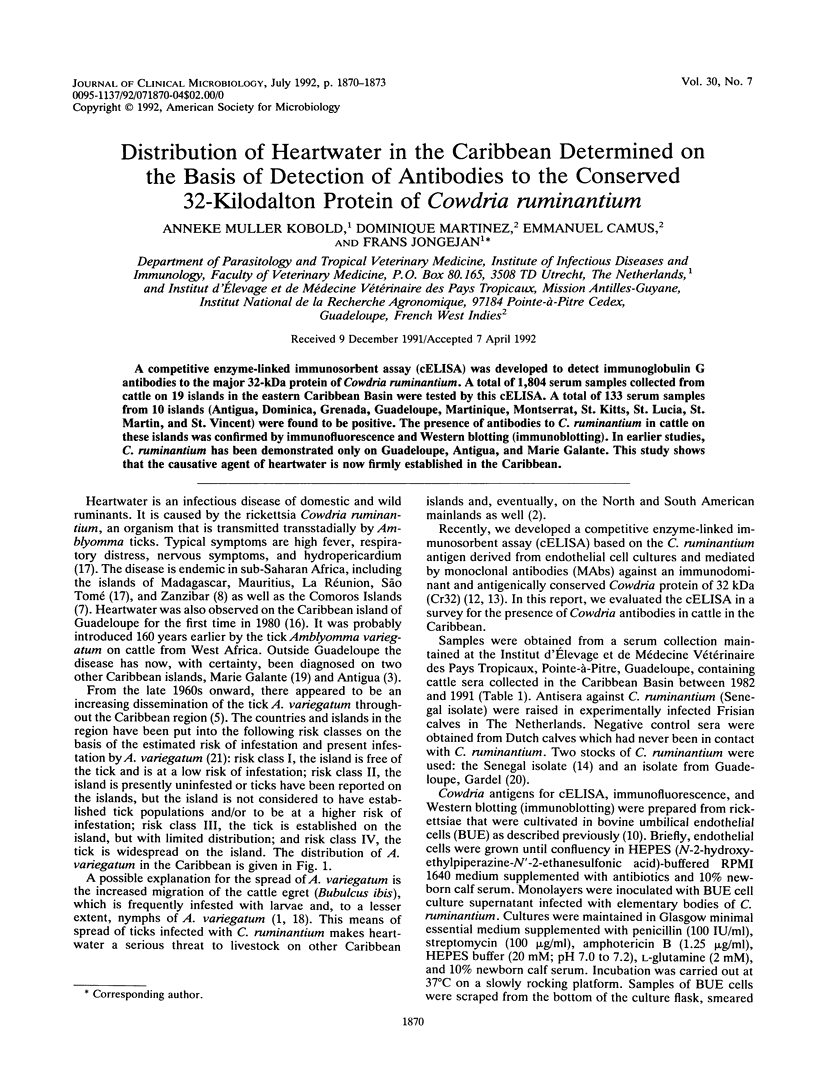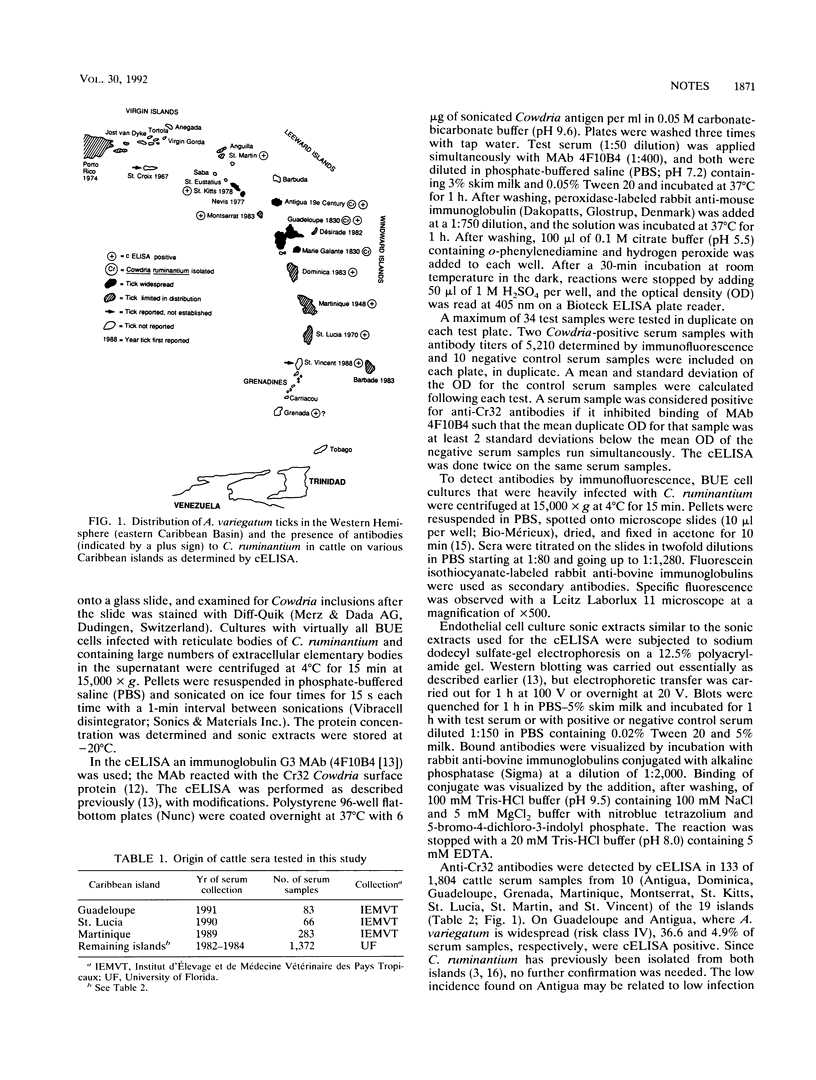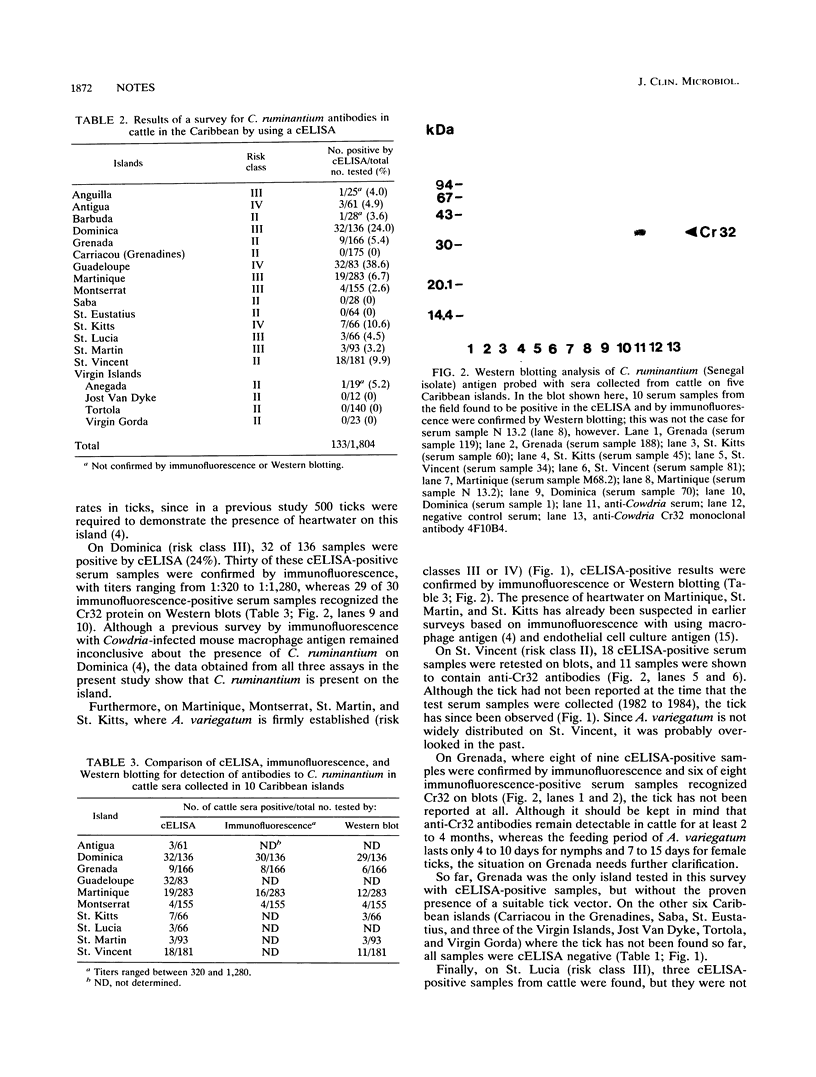Abstract
A competitive enzyme-linked immunosorbent assay (cELISA) was developed to detect immunoglobulin G antibodies to the major 32-kDa protein of Cowdria ruminantium. A total of 1,804 serum samples collected from cattle on 19 islands in the eastern Caribbean Basin were tested by this cELISA. A total of 133 serum samples from 10 islands (Antigua, Dominica, Grenada, Guadeloupe, Martinique, Montserrat, St. Kitts, St. Lucia, St. Martin, and St. Vincent) were found to be positive. The presence of antibodies to C. ruminantium in cattle on these islands was confirmed by immunofluorescence and Western blotting (immunoblotting). In earlier studies, C. ruminantium has been demonstrated only on Guadeloupe, Antigua, and Marie Galante. This study shows that the causative agent of heartwater is now firmly established in the Caribbean.
Full text
PDF



Images in this article
Selected References
These references are in PubMed. This may not be the complete list of references from this article.
- Barré N., Uilenberg G., Morel P. C., Camus E. Danger of introducing heartwater onto the American mainland: potential role of indigenous and exotic Amblyomma ticks. Onderstepoort J Vet Res. 1987 Sep;54(3):405–417. [PubMed] [Google Scholar]
- Birnie E. F., Burridge M. J., Camus E., Barré N. Heartwater in the Caribbean: isolation of Cowdria ruminantium from Antigua. Vet Rec. 1985 Feb 2;116(5):121–123. doi: 10.1136/vr.116.5.121. [DOI] [PubMed] [Google Scholar]
- Camus E., Barré N. Epidemiology of heartwater in Guadeloupe and in the Caribbean. Onderstepoort J Vet Res. 1987 Sep;54(3):419–426. [PubMed] [Google Scholar]
- Dilbeck P. M., Evermann J. F., Crawford T. B., Ward A. C., Leathers C. W., Holland C. J., Mebus C. A., Logan L. L., Rurangirwa F. R., McGuire T. C. Isolation of a previously undescribed rickettsia from an aborted bovine fetus. J Clin Microbiol. 1990 Apr;28(4):814–816. doi: 10.1128/jcm.28.4.814-816.1990. [DOI] [PMC free article] [PubMed] [Google Scholar]
- Du Plessis J. L., Van Gas L., Olivier J. A., Bezuidenhout J. D. The heterogenicity of Cowdria ruminantium stocks: cross-immunity and serology in sheep and pathogenicity to mice. Onderstepoort J Vet Res. 1989 Sep;56(3):195–201. [PubMed] [Google Scholar]
- Flach E. J., Woodford J. D., Morzaria S. P., Dolan T. T., Shambwana I. Identification of Babesia bovis and Cowdria ruminantium on the island of Unguja, Zanzibar. Vet Rec. 1990 Jan 20;126(3):57–59. [PubMed] [Google Scholar]
- Jongejan F. Protective immunity to heartwater (Cowdria ruminantium infection) is acquired after vaccination with in vitro-attenuated rickettsiae. Infect Immun. 1991 Feb;59(2):729–731. doi: 10.1128/iai.59.2.729-731.1991. [DOI] [PMC free article] [PubMed] [Google Scholar]
- Jongejan F., Thielemans M. J., De Groot M., van Kooten P. J., van der Zeijst B. A. Competitive enzyme-linked immunosorbent assay for heartwater using monoclonal antibodies to a Cowdria ruminantium-specific 32-kilodalton protein. Vet Microbiol. 1991 Jul;28(2):199–211. doi: 10.1016/0378-1135(91)90093-u. [DOI] [PubMed] [Google Scholar]
- Jongejan F., Thielemans M. J. Identification of an immunodominant antigenically conserved 32-kilodalton protein from Cowdria ruminantium. Infect Immun. 1989 Oct;57(10):3243–3246. doi: 10.1128/iai.57.10.3243-3246.1989. [DOI] [PMC free article] [PubMed] [Google Scholar]
- Jongejan F., Uilenberg G., Franssen F. F., Gueye A., Nieuwenhuijs J. Antigenic differences between stocks of Cowdria ruminantium. Res Vet Sci. 1988 Mar;44(2):186–189. [PubMed] [Google Scholar]
- Martinez D., Swinkels J., Camus E., Jongejan F. Comparaison de trois antigènes pour le sérodiagnostic de la cowdriose par immunofluorescence indirecte. Rev Elev Med Vet Pays Trop. 1990;43(2):159–166. [PubMed] [Google Scholar]
- Perreau P., Morel P. C., Barre N., Durand P. Existence de la cowdriose (heartwater) à Cowdria ruminantium chez les ruminants des Antilles françaises (la Guadeloupe) et des Mascareignes (la Réunion et Ile Maurice). Rev Elev Med Vet Pays Trop. 1980;33(1):21–22. [PubMed] [Google Scholar]
- Uilenberg G., Camus E., Barré N. Quelques observations sur une souche de Cowdria ruminantium isolée en Guadeloupe (Antilles françaises). Rev Elev Med Vet Pays Trop. 1985;38(1):34–42. [PubMed] [Google Scholar]
- Uilenberg G. Extension de la tique Amblyomma variegatum dans les Antilles: comment expliquer cette grave menace et que faire? Rev Elev Med Vet Pays Trop. 1990;43(3):297–299. [PubMed] [Google Scholar]
- Uilenberg G. Heartwater (Cowdria ruminantium infection): current status. Adv Vet Sci Comp Med. 1983;27:427–480. [PubMed] [Google Scholar]



